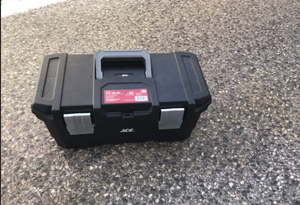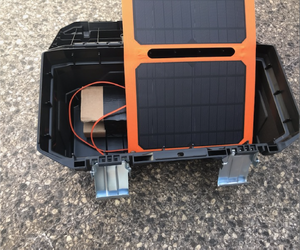
Cassiopeia is a portable and durable computer capable of running completely off solar radiation and able to work without access to the Internet. The design consists of a raspberry pi 3b+, 10W fold-able solar panel, lithium-ion rechargeable battery, and container to house it all. The project was designed and built in the spring 2022 by Cal Poly Humboldt students enrolled in Engineering 215: Introduction to Design. The team, Suns of Community, consisted of Zane Cook, Max Cunningham, and Phil Tran. The design was inspired by the desire to be able to access resources and information to aid in survival and off grid living without the need for the Internet. Cassiopeia displays all of Wikipedia and selected articles of Appropedia through their mobile smart phone
Background[edit | edit source]
The spring of 2022 ENGR 215 class at Cal Poly Humboldt have taken on a design project on behalf of Appropedia. This website is dedicated to creating a platform where users can interact with one another to help create solutions for sustainability, poverty reduction, and international development by providing users with the information to build appropriate technologies. Our team, "Suns of Community", have been tasked with building a portable and durable apocalypse computer powered through solar radiation and using inexpensive and/or commonly found items. Emilio, the Executive Director of Appropedia, was the client and he provided guidance for the development of the design.
Problem Statement[edit | edit source]
The objective of Suns of Community is to create a portable computer housed in a durable container that is capable of running for several years off solar radiation and without access to an electrical grid or the Internet. This computer, Cassiopeia, will provide users with valuable information from Wikipedia and Appropedia on survival strategies and DIY engineering systems through their mobile devices that will enable them to live off grid for long periods of time.
Criteria:
Through guidance by Emilio, the Suns of Community developed the following criteria to guide the design process of the Cassiopeia. Each criteria was weighted on a scale of 1-10 with a score of 10 meaning highest importance.
| Criteria | Description | Weight (1-10) |
| Cost | The amount of money spent on acquiring materials, construction, and maintaining the design. The design must not exceed $250. | 7 |
| Durability | The ability of the design to withstand inclement weather, temperatures between 32F and 104F, and normal use over 10 years. | 8 |
| Reproducibility | Having a general knowledge of computers, soldering, and access to a raspberry pi, power bank, smartphone, Internet, and computer. | 7 |
| Ease of Access | Screen must output pictures and text in color and have the ability to zoom in. | 7 |
| Portability | Design must be transportable, weigh no more than 5 lbs, and fit into a medium sized backpack. Solar panels need to be foldable and whole system needs to be able to handle moderate jostling | 8 |
| Capabilities | Have enough data storage to fit Wikipedia and Appropedia, able to connect with mobile devices, and charge the power bank or Raspberry Pi | 6 |
Prototyping[edit | edit source]
Describe your design here.
-
Sample caption text.
-
-
More sample caption text.
-
-
Even more sample caption text.
Final Product[edit | edit source]
Once research and prototyping were completed, a final design was chosen. The case consisted of a hard plastic toolbox that is durable, portable, and has room for small miscellaneous items. The Raspberry Pi and power bank are housed in their own case. All items are capable of being removed while also capable of being secured in the box with Velcro.


Construction[edit | edit source]
Bill of Materials
| Materials | Use | Quantity | Project cost ($) | Projected Project Cost ($) |
|---|---|---|---|---|
| Raspberry Pi | CPU | 1 | Donated | |
| Solar panel | Power source | 1 | 59.89 | |
| Power bank | Store/release energy | 1 | donated | |
| SD Card | Storage for data and code | 1 (128 GB) | 54.24 | |
| Voltage regulator | Ensuring correct voltage reaches components | 1 | donated | |
| Inner case | Houses Raspberry Pi & Power bank | 1 | ||
| Outer case | Houses everything | 1 | 20.00 | |
| Power cable | Connecting components | 1 | ||
| Software | Code that enables hotspot | 1 | Free download |
Maintenance[edit | edit source]
The table below displays the component concerned, how often to perform maintenance, and the projected cost per year.
| Maintenance Task | Frequency | Cost ($)/ number of years |
|---|---|---|
| Replace Raspberry Pi | 7-10 years | 30 - 90 / 7 - 10 |
| Replace solar panel | 25 - 30 years | 50 / 25-30 |
| Replace power bank | 3-4 years | 20 / 3-4 |
| Replace SD card | 10 years | 60 / 10 |
Instructions[edit | edit source]
The Cassiopeia is capable of being powered through photovoltaics as well as through a Li-ion power bank. To power the computer through PV, simply connect the micro usb to the solar panel and raspberry pi during a sunny day. For mobile use, or use during times of limited sunlight you would simply connect your micro usb to the power bank and raspberry pi.
Implementation[edit | edit source]
To make this you will need; a computer, raspberry pi, solar panel, box, cables, free space on comp, sd card, power bank.
Use[edit | edit source]
To use it you will need to plug in, connect to hotspot, use the kiwix url and search through the database. From here as long as you are in range to the raspberry pi you will be able to access information to wikipedia as well as appropedia.
Discussion[edit | edit source]
Your discussion.
Next steps[edit | edit source]
The next steps.
Conclusions[edit | edit source]
Testing Results[edit | edit source]
During testing we found it works well in an open environment as well as in the forest. During the connection process we discovered that there are times it is difficult to access kiwix from your phone through the suggested link. To overcome this problem our team plans on developing a QR code that is printed on the containing box that will help the user access this link directly.
References[edit | edit source]
Contact details[edit | edit source]
Add your contact information.
